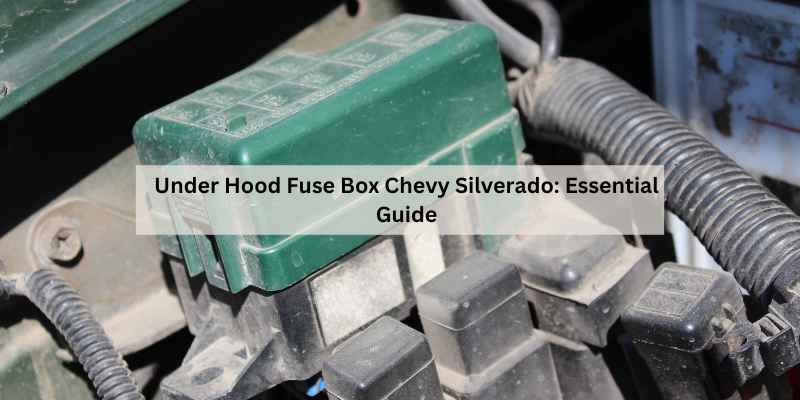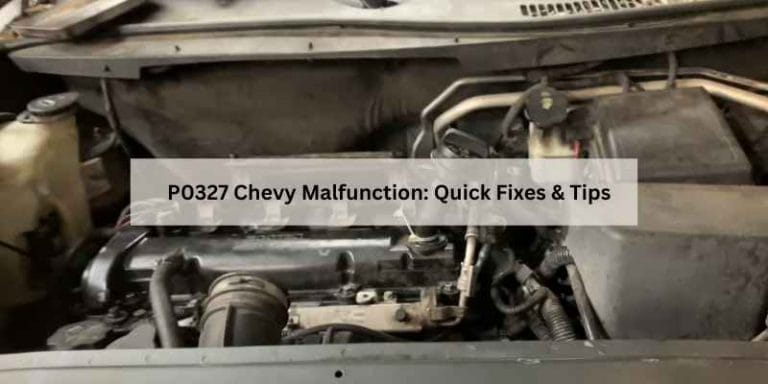Under Hood Fuse Box Chevy Silverado: Essential Guide
The under hood fuse box in a Chevy Silverado protects essential engine components. It typically houses fuses for the engine control unit, cooling fan, and battery.
Understanding the role of the under hood fuse box in your Chevy Silverado is crucial for vehicle maintenance. This fuse box is located near the battery, ensuring quick access for troubleshooting. It contains various fuses that protect vital engine components from electrical issues.
Regularly checking these fuses can prevent costly repairs and ensure your vehicle runs smoothly. If a component stops working, a blown fuse might be the culprit. Familiarizing yourself with the fuse layout and their specific functions can empower you to address minor electrical problems effectively. Knowing how to locate and replace fuses enhances your overall vehicle knowledge.
Introduction To The Under Hood Fuse Box In Chevy Silverado
The under hood fuse box in a Chevy Silverado plays a crucial role. It protects vital engine components from electrical issues. Without this fuse box, important systems could fail.
Key components safeguarded by the fuse box include the engine control unit (ECU), cooling fan, ABS motor, and battery. Each of these parts is essential for the vehicle’s proper functioning.
| Component | Function |
|---|---|
| Engine Control Unit (ECU) | Manages engine operations |
| Cooling Fan | Regulates engine temperature |
| ABS Motor | Ensures braking efficiency |
| Battery | Powers electrical systems |
Identifying The Fuse Box Location
Finding the fuse box in a Chevy Silverado can be simple. The fuse box is usually located near the battery. Look for a black plastic cover on top. This cover protects the fuses from damage.
Some common challenges include difficulty spotting the fuse box. Lighting conditions under the hood might not be ideal. Using a flashlight can help illuminate the area. Another issue is identifying which fuse to replace. A fuse diagram is often located inside the fuse box cover.
To avoid confusion, keep your owner’s manual handy. It provides detailed information about the fuse box. Knowing the exact location and function of each fuse is essential for repairs.
Understanding Fuse Box Components
The under hood fuse box of a Chevy Silverado contains several key components. These parts play vital roles in protecting the vehicle’s electrical systems.
Fuse Links: These are safety devices that prevent overloads. They automatically disconnect the circuit during a fault.
Relays: These act as switches. They control high-current devices like the cooling fan and starter motor.
Fuses: Fuses protect specific electrical circuits. If a fuse blows, it stops electricity flow to that part.
Battery Terminal: This connects the battery to the fuse box. It ensures power supply to the components.
Understanding these components helps in maintaining and troubleshooting the electrical system of your vehicle.
How To Safely Access Your Fuse Box
Gather the right tools before accessing your fuse box. You will need a screwdriver, flashlight, and a pair of gloves. These items ensure safety and make the task easier.
Follow these steps to access your fuse box:
- Park your Chevy Silverado on a flat surface.
- Turn off the engine and remove the keys.
- Open the hood and secure it with the prop rod.
- Locate the fuse box, usually near the battery.
- Remove the cover carefully to avoid damage.
Always handle fuses with care. Check each fuse for any burnt connections. Replace any faulty fuses to keep your vehicle running smoothly.
Troubleshooting Common Fuse Box Problems
Common signs of fuse box issues include blown fuses, burnt smells, or flickering lights. Engine troubles may arise, indicating a faulty fuse box. If your electrical components stop working, it might be time to inspect the fuse box.
For DIY troubleshooting, start by checking the fuses. Look for any that appear burnt or damaged. Replace any blown fuses with the correct amperage. Ensure connections are tight and free from corrosion. A multimeter can help check for continuity in the fuses and wiring.
Always consult your vehicle’s manual for specific fuse box information. Keeping a record of any issues can help track recurring problems.
Replacing Fuses: A Practical Guide
Recognizing when to replace a fuse is essential for vehicle safety. If electrical components fail, check the fuses first. A blown fuse usually appears with a broken metal strip inside. Look for signs like dim lights or non-working accessories.
The step-by-step replacement procedure is simple. First, turn off the vehicle. Next, locate the fuse box under the hood. Remove the cover to access the fuses. Identify the faulty fuse using the diagram on the cover. Carefully pull it out with needle-nose pliers.
Replace it with a new fuse of the same amperage. Finally, snap the cover back on and start your vehicle. Regularly check fuses to maintain your Chevy Silverado’s performance.
Maintenance Tips For Your Fuse Box
Regular checks help maintain your Chevy Silverado’s fuse box. Use this routine inspection checklist:
- Inspect the fuse box cover for cracks or damage.
- Ensure all fuses are securely in place.
- Look for signs of corrosion on terminals.
- Check for any burnt fuses and replace them promptly.
- Keep the area around the fuse box clean and free of debris.
Following these preventive maintenance tips can extend the life of your vehicle’s electrical system. Regular maintenance prevents unexpected breakdowns and ensures a smooth driving experience.
Professional Help And Resources
Professional help is essential for certain fuse box issues. Signs include frequent blown fuses, unusual electrical behavior, or persistent warning lights. If you’re unsure about the problem, consulting a mechanic is wise.
Several resources can enhance your understanding of fuse boxes in Chevy Silverado. Websites like YouTube and Car Gurus offer valuable video tutorials. Forums dedicated to Chevy owners provide helpful community insights. Books on car maintenance also serve as great references.
| Resource Type | Recommended Sources |
|---|---|
| Video Tutorials | YouTube, Car Gurus |
| Forums | Chevy Silverado Forums |
| Books | Car Maintenance Guides |
Frequently Asked Questions
How Many Fuse Boxes Does A Chevy Silverado Have?
A Chevy Silverado typically has two fuse boxes. One is located under the hood, and the other is inside the cabin, usually near the driver’s side dashboard.
What Is The Fuse Box Under The Hood?
The fuse box under the hood houses fuses that protect critical engine components. It safeguards systems like the engine control unit, cooling fan, and ABS motor. This box ensures reliable vehicle operation by preventing electrical overloads and shorts in the engine compartment.
How Do You Get To The Interior Fuse Box?
To access the interior fuse box, locate it on the driver’s side dashboard or beneath the glove box. Some models may have it in the trunk. Open the cover to reveal the fuses. Always refer to your vehicle’s manual for specific instructions.
What Is The Engine Room Fuse Box?
The engine room fuse box houses fuses that protect various engine components. It’s typically located near the battery, ensuring electrical systems function correctly. This box prevents electrical overloads, maintaining vehicle safety and performance. Regular checks can help identify any blown fuses that need replacement.
Conclusion
Understanding the under hood fuse box in your Chevy Silverado is essential for vehicle maintenance. This knowledge helps prevent electrical issues and ensures your truck runs smoothly. Regularly check the fuses and replace any that are blown. A well-maintained fuse box can save you time and costly repairs in the long run.







